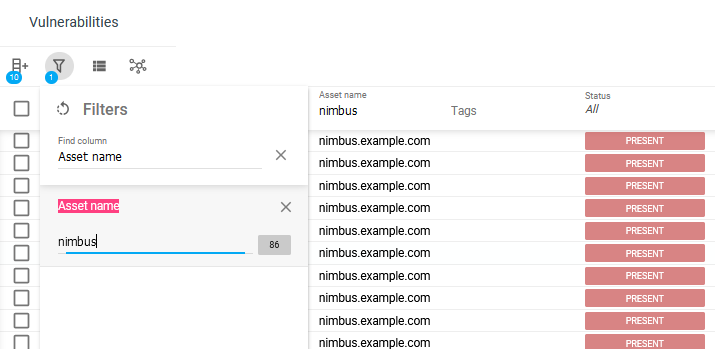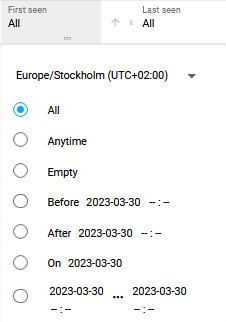Filters
Last Updated: 2025-02-06
Purpose
This article provides an overview of the Filter and Settings panel feature.
Introduction
Common Settings include filtering options, and settings to customize the view.
Filters allow for quick limitation of viewed data to relevant entries. By applying filters in multiple columns, it is possible to narrow down a large dataset to find a particular entry or to discover any abnormalities, missing data or missing actions.
When looking for a particular hostname (that includes a number in domain name) in Assets view, choose Hostname in the Type column and enter that number in the Name column to narrow down the search results. Additionally, a scanner ID can be submitted to ensure a direct search result.
Customize each view by adding or removing the columns and by applying filters. Each view has a Filter and Settings panel. To access it, click the filter ![]() icon in the bar spanning along the left edge of the table. This displays the Filter and Settings panel.
icon in the bar spanning along the left edge of the table. This displays the Filter and Settings panel.
Inside the Filter panel, it is possible to add or remove columns, apply filters, view templates, and change column width and make it persist on your account.
Requirement
It is assumed that the reader has basic access to the OUTSCAN/HIAB account to access the Portal.
Filter Tab
To access the filtering, click the filter ![]() icon on the top right side of the screen. A list of available columns is displayed:
icon on the top right side of the screen. A list of available columns is displayed:

Use the Find Column field to quickly find the column name of choice in the list of applied filters.

Applying Filter
To apply a filter enter the filtration string either on the top of the column or in the Filter tab.

Filter Expression
Expression | Example | Description |
|---|---|---|
? | Single character wildcard St??ng | Replace any character with the same number of "?". Example: W??d will find Word, Wood, and Wand but reject Would. |
! | Exclude. !<string> !null | Excludes rows starting with <string>. Example: !Word excludes all rows starting with Word. Excludes empty rows. |
null | Empty | Presents only empty rows |
< | Less than number or date <10 | Limits results to less than specified number. Only applicable to underlying numerical data such as numbers and dates. Example: <6.4 Includes only rows below 6.4 that are non-empty. Example: <2022-10-31 Includes only rows before 2022-10-31 that are non-empty. |
> | Larger than number or date >0 | Limits results to more than specified number. Only applicable to underlying numerical data such as numbers and dates. Example: >3.2 Includes only rows above 3.2 that are non-empty. Example: >2022-10-31 Includes only rows past 2022-10-31 that are non-empty. |
- | Inclusive numerical range 3.2-7 | Filters out items within the specified number range. Example: 1-5.5 will filter out items having the value 3.2 up to 5.5, inclusive. |
, | Boolean AND (comma) a,b | Provides results that contain both or all keywords. Example: a,b => a AND b |
| | Boolean OR (pipe) a|b | Provides results that contain either keyword. Example: a|b => a OR b Combinations can be done: a,b|c => (a AND b) OR c a,b|c,b => (a AND b) OR (c AND b) |
A filter can be applied in the background. This allows for enabling only columns of interest while filtering by any columns, without the need of specifically having them visible in the table to enable filtering. Pay extra attention to the Filter counter beside the column name to see how many filters are applied to the table.
Date Filters
Date specific filters are presented in a drop-down menu.

Option | Description |
|---|---|
All | All results without filter. |
Anytime | Everything with a timestamp. (Empty fields excluded) |
Empty | Everything without a timestamp. (All the empty fields) |
Before | Everything before the set date and time. (set time not included) |
After | Everything after the set date and time. (set time included) |
On | "On" means on that date, with that timezone so including 00:00 to 23:59 that day. |
When selecting a date in the filters, a date picker is displayed.

Column Filters
Filters can be applied directly in the column head.
Clearing Filters
The × icon next to the search field restores the search phrase and lists all columns unfiltered.
The clear filter![]() icon to the top right clears all of the filters applied to the table. Clicking the X on a specific filter removes that filter only.
icon to the top right clears all of the filters applied to the table. Clicking the X on a specific filter removes that filter only.

Filters can also be cleared using the clear filter ![]() icon at the bottom left of the view.
icon at the bottom left of the view.

Copyright
© 2026 Outpost24® All rights reserved. This document may only be redistributed unedited and unaltered. This document may be cited and referenced only if clearly crediting Outpost24® and this document as the source. Any other reproduction and redistribution in print or electronically is strictly prohibited without explicit permission.
Trademark
Outpost24® and OUTSCAN™ are trademarks of Outpost24® and its affiliated companies. All other brand names, product names or trademarks belong to their respective owners.
